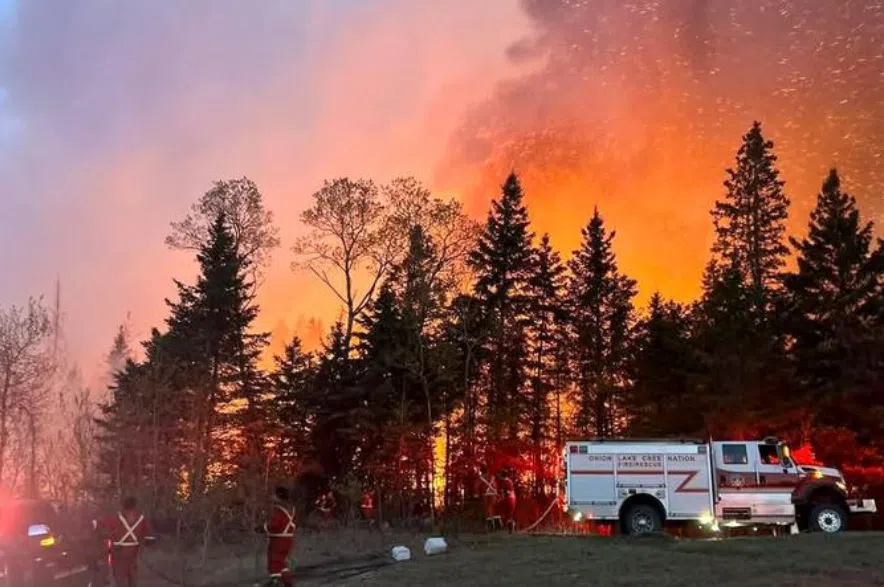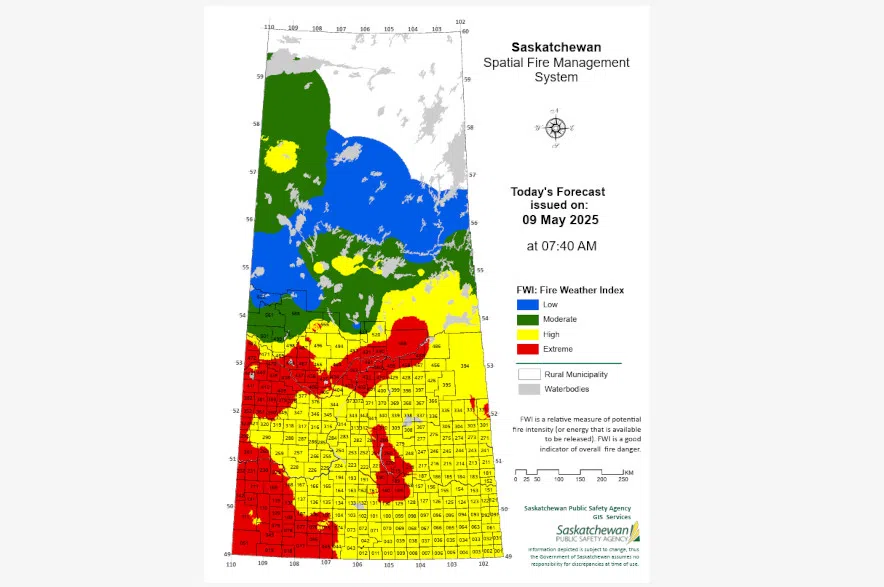As the Saskatchewan Public Safety Agency (SPSA) issued a fire ban on Thursday for part of northern Saskatchewan, much of the southern half of the province was showing extreme and high fire risk through this week.
The SPSA’s fire ban covers the area north of the provincial forest boundary and up to the Churchill River.
Read more:
- Village of Alvena issues water rationing notice as wildfire burns nearby
- Evacuations ordered as 4 homes burn in uncontained wildfire on James Smith Cree Nation
- Video: Regina crews battle wind in effort to control grass fire near Co-op Refinery
Byron Chartrand, the executive director of land management with the SPSA, said the ban is due to the current dry conditions, high fire activity and extreme fire risk, and has come earlier this year than in the past.
The province is also encouraging other municipalities to consider implementing their own fire bans.
As of Friday morning, there were 24 active wildfires in the province — 12 contained, nine not contained and three were still being assessed.
Chartrand said there’s been minimal lightning this year, so all the fires so far have been caused by human activity.
“(ATVs), you know, riding and a spark starts a fire in the dry grass. Or it could be people burning brush or something on their property that got away due to the wind, right down to other fires that could be more malicious and arson-like which are being investigated,” he explained.
There have been 135 wildfires in the province so far this year, which is 19 more than this time last year and more than twice the five-year average.
Priorities shift quickly when it comes to active wildfires, but Chartrand said they were keeping an eye on one near Onion Lake because of the large community nearby and had been watching the one that’s affecting the lower Fishing Lake & Park area, which is now controlled and contained.
Deputy fire chief of the Wadena district fire department Brian Weber, said around 10:30 p.m. on Thursday night firefighters responded to a call about the grass fire threatening homes on Fishing Lake First Nation.
He said the grass fire spread to bush and firefighters were on the scene until 4 a.m. on Friday. Weber said there were no injures and no houses were lost.
Althought the fire is now controlled and contained, but crews continue to work on ember and bush burn. Now the Fishing Lake Fire Department has taken over the rest of the job.
“Due to the back-burn, we were able to keep the fire from spreading outside of the large bush area,” Weber said. “The houses that were inside the bush area were protected and the fire was driven back from the houses.”
The cause of the fire is unknown.
Chartrand said the SPSA is also closely watching the fire near the Meadow Lake campground to get a handle on it before campgrounds open up.
The southern half of the province has been shown on SPSA maps with extreme and high fire risks all this week. Chartrand said it’s because of the drought.
“Last fall, last summer it was very hot and dry as well. We did get a fair amount of moisture throughout the winter with snow, but the soil is just so dry that we didn’t get that reprieve and whatever melted off this spring the ground just absorbed due to the conditions,” he explained.
Chartrand said it could be another intense summer for fires.
“If these conditions continue then yes, it would be a very, very busy summer for us. But we are hopeful that we will get some spring rains and a couple days of showers will change our conditions quite drastically,” he said.
Chartrand said he is concerned that there are more fires to date this year, but he said nature runs in cycles and the province appears to be in a higher part of that cycle right now.
“Hopefully, in the coming years we’ll be experiencing better conditions, but only time will tell,” he said.
— with files from Mia Holowaychuk, 650 CKOM












